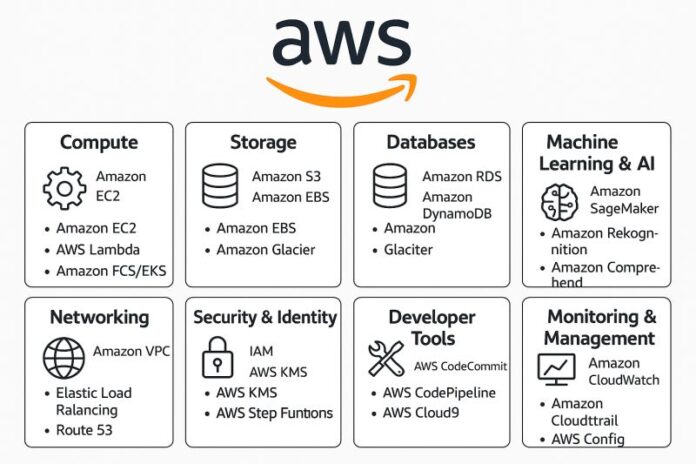AWS (Amazon Web Services)
AWS (Amazon Web Services) is a comprehensive and widely adopted cloud computing platform. It provides a broad set of on-demand services that help individuals, businesses, and governments build and manage applications and infrastructure over the internet.
Here are the main categories of AWS services:
1. Compute
- Amazon EC2 (Elastic Compute Cloud): Virtual servers to run applications.
- AWS Lambda: Serverless computing—run code without managing servers.
- Amazon ECS/EKS: Container services for Docker and Kubernetes.
2. Storage
- Amazon S3 (Simple Storage Service): Scalable object storage.
- Amazon EBS (Elastic Block Store): Block storage for EC2 instances.
- Amazon Glacier / S3 Glacier: Long-term archival storage.
3. Databases
- Amazon RDS: Managed relational databases (MySQL, PostgreSQL, etc.).
- Amazon DynamoDB: NoSQL database service.
- Amazon Redshift: Data warehousing and analytics.
4. Networking
- Amazon VPC (Virtual Private Cloud): Isolated networks in AWS.
- Elastic Load Balancing (ELB): Distributes traffic across servers.
- Route 53: Scalable DNS and domain name registration.
5. Security & Identity
- IAM (Identity and Access Management): Manage users and permissions.
- AWS KMS: Key management for encryption.
- AWS Shield / WAF: DDoS protection and web application firewall.
6. Machine Learning & AI
- Amazon SageMaker: Build, train, and deploy ML models.
- Amazon Rekognition: Image and video analysis.
- Amazon Comprehend: Natural language processing.
7. Application Integration
- Amazon SQS: Message queuing service.
- Amazon SNS: Notification service.
- AWS Step Functions: Coordinate distributed applications.
8. Developer Tools
- AWS CodeCommit: Source control.
- AWS CodePipeline: Continuous integration and delivery.
- AWS Cloud9: Cloud-based development environment.
9. Monitoring & Management
- Amazon CloudWatch: Logs and performance monitoring.
- AWS CloudTrail: Tracks user activity and API usage.
- AWS Config: Monitors configuration changes
Conclusion:
In essence, Amazon Web Services (AWS) stands as the preeminent global leader in cloud computing. Its vast, ever-expanding portfolio of on-demand services empowers individuals, businesses of all sizes, and governmental entities to transform how they build, deploy, and scale applications and infrastructure.
By offering unparalleled scalability, robust reliability, and significant cost-efficiency through its pay-as-you-go model, AWS removes traditional barriers to technological innovation and agility. It provides the essential foundation for digital transformation, enabling users to focus on their core objectives rather than managing complex physical data centers. AWS’s comprehensive capabilities and widespread adoption solidify its critical role as the backbone powering a vast ecosystem of modern digital solutions worldwide.






